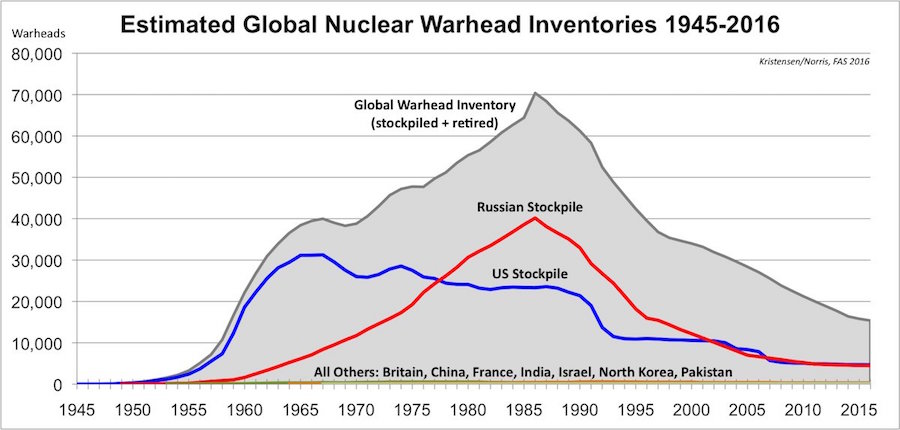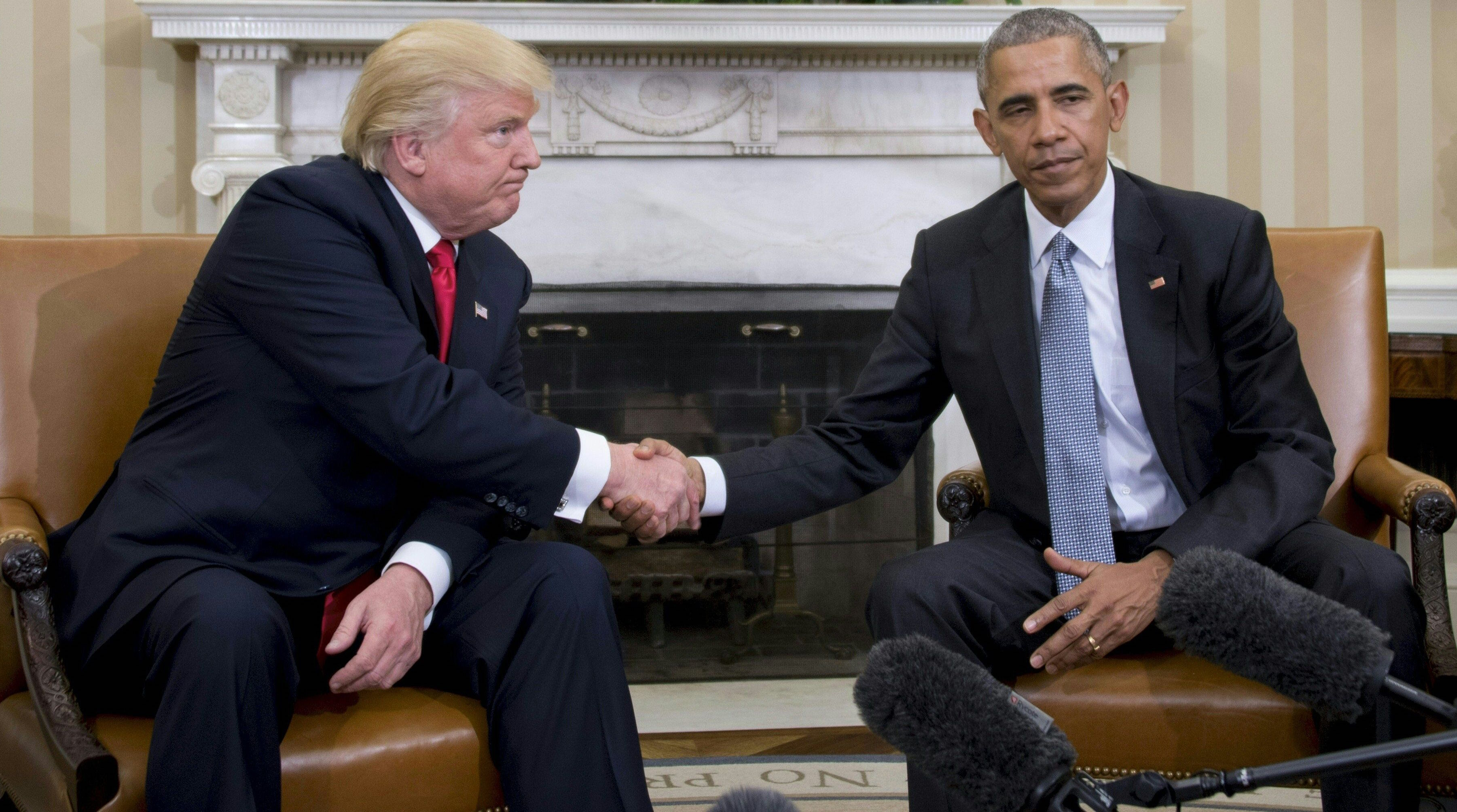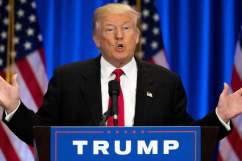
Mushroom cloud from a hydrogen bomb, in a nuclear test carried out in 1971. (Getty)
When Donald Trump takes office as President of the United States immediately following his inauguration on January 20, 2017, he assumes one awesome responsibility that overshadows all of his other duties. Trump will take charge of the United States nuclear weapons arsenal — with enough power to end all life on planet Earth literally at his fingertips.
But Trump’s election has caused alarm around the world, as foreign policy experts and other world leaders fear that Trump, who during the presidential campaign expressed willingness to use nuclear weapons, could unleash World War 3 — perhaps a nuclear war this time.
Could Trump start a nuclear war? What would it take for him to unleash the ultimate disaster?
Here’s what you need to know.
1. There are About 15,000 Nuclear Weapons in the World

Graph by Federation of American Scientists showing current levels of nuclear weapons. (FAS)
According to the Federation of American Scientists, the quantity of nuclear weapons in the world has been declining since the mid-1980s. In 1986, as the Cold War between the United States and the Soviet Union remained at a high level of tension, the number of nuclear weapons hit an all-time high of 70,300.
But since the end of the Cold War in the early 1990s those nuclear arsenals have declined, dropping sharply throughout the ’90s and then continuing to decline — at a slower pace — as countries continued to dismantle the weapons. Currently, the FAS estimates that about 15,350 nukes exist in the world.
How many of those will be at the disposal of President Trump? According to FAS estimates, the United States currently has 1,750 deployed “strategic” nuclear weapons,” and 180 “tactical,” sometimes called “non-strategic” nuclear warheads ready to fire — total of 1,930 nuclear weapons that will be completely under Trump’s control as soon as he becomes the 45th President of the United States.
“We still have more than enough nuclear weapons to trigger a full-scale nuclear winter that would destroy food production worldwide,” Alan Robock, a Rutgers University scientist, said in an interview with BuzzFeed News. “It would be a horrible holocaust that destroys humanity.”
Strategic nuclear weapons are usually defined as bombs or warheads that can be targeted over great distances, anywhere in the world. Tactical nuclear weapons are, theoretically, fired under “battlefield” conditions against a specific enemy in combat.
Tactical weapons tend to be smaller and to carry less massive explosive power than strategic nuclear weapons. But they are also considered more dangerous to the security of the world, because they can be more easily stolen and used by unauthorized persons, such as terrorists, without being delivered by a bomber jet, or on the end of an ballistic missile, according to a 2010 U.S. Air Force report.
2. U.S. Policy Allows for A Nuclear ‘First Strike’
If President Trump started a nuclear war, he would not be violating current U.S. nuclear policy.
Since the dawn of the Cold War in the late 1940s, the United States has adopted a “first strike” policy when it comes to using nuclear weapons. In other words, the U.S. does not need to wait until its own territory or interests are attacked with nuclear weapons before unleashing a nuclear strike.
For decades, U.S. military strategists have concocted plans for starting a nuclear war — generally in response to hostilities such as a possible Russian invasion of western Europe.
President Barack Obama has not altered the current policy, but according to reports from inside his administration, the current president has pushed for the country to move to a “no first strike” policy — meaning that the U.S. would never plan to initiate a nuclear war or exchange — only to meet with resistance from his military advisers.
Advocates of “no-first-strike,” such as the prestigious Bulletin of Atomic Scientists, say that ditching the first-strike option would have the effect of creating a more sensible, and cost-effective, nuclear policy without sacrificing national security — because the U.S. nuclear arsenal is really maintained only as a deterrent anyway.
By taking away the first-strike option, the U.S. would reduce the chance of an accidental or unauthorized launch by a rogue battlefield commander, such as seen in the classic 1962 film Dr. Strangelove or How I Learned to Stop Worrying and Love the Bomb, as seen in the clip above.
3. There Will be No Restrictions on Trump’s Use of Nuclear Weapons

As president, Donald Trump will have no checks on his ability to launch a nuclear war.
Will there be any restrictions, any checks and balances, on the ability of a President Trump to start a nuclear war, or launch a nuclear first strike?
The short answer is — no. There is nothing in any U.S. law or military procedure that prevents any president from launching a nuclear strike — for any reason, according to a Brookings Institute report earlier this year.
Technically, the 1973 War Powers Act requires the president to gain congressional approval for any use of force within 60 days of starting any military action. But in the case of a nuclear war, the Brookings report said, the 60-day requirement is essentially irrelevant.
“A nuclear war could easily devastate the planet within just days or hours—long before the 60-day stipulation would be binding,” the report stated. “Even if a president had obtained congressional approval for a war that began using only conventional weapons, no provisions of the War Powers Act would require subsequent congressional action prior to nuclear escalation.
Presumably, Trump would face enormous pressure from the Pentagon and perhaps his own advisers to refrain from launching nuclear weapons. But if he decides he wants to attack anywhere in the world with a nuclear weapon, or a barrage of nuclear bombs and warheads, it’s totally up to him. All he needs to do is give the go-ahead.
And use the right codes, of course.
4. President Trump Can Launch a Nuclear Attack in a Matter of Minutes

On January 20, Barack Obama (r) will hand the nuclear launch codes to new President Donald Trump (l). (Getty)
For Trump to launch a nuclear attack would be pretty easy, even easier than depicted in the fictional 1983 film The Dead Zone, in which an insane president launches a nuclear strike simply because he believes to do so is his “destiny.” But as seen in the clip below, the Dead Zone president portrayed by Martin Sheen must first have an adviser authorize the strike before he, himself, pushed the red button (the existence of which is also fiction).
In reality, when Trump is inaugurated, Obama — or one of his top security officials — will hand Trump a special card known in slang terms as “the biscuit.” On the “biscuit” are written the top secret codes which identify the president and give the go ahead to launch a nuclear attack.
All Trump must do is transmit those codes to his nuclear commanders.
He will also consult a special book carried around in a briefcase called The Presidential Emergency Satchel, but better known as “the football.” That book contains his numerous options for targeting a strike, and another book carried in the “football” lists top secret hidden bunkers where Trump, or any president, could take shelter and safely wait out the nuclear war he has started.
“You have to be ready anytime for any moment,” Pete Metzger, who carried the “football” for President Ronald Reagan, told CNN. “It has to happen quickly, because the time on a missile is very fast.”
The presidential aide who carries the Emergency Satchel must undergo a strict regimen of security background checks and psychological tests. But President Trump will not be required to go through any such vetting.
5. Trump has Already Said he Might Use Nuclear Weapons
During the presidential campaign Trump made numerous statements regarding his views on use of nuclear weapons — statements that were seen by experts and foreign leaders as revealing Trump’s reckless and cavalier attitude toward use of the ultimate weapons.
Among those statements, Trump said he would never “rule out” using nuclear weapons, and in an interview with MSNBC’s Chris Matthews has questioned why the U.S. manufactures nuclear weapons unless it intends to use them. In fact, when asked whether he would consider using nuclear weapons against targets within Europe, Trump refused to rule out that option either, saying, “Europe’s a big place.”
Trump also said that he intended his use of nuclear weapons as president to be “unpredictable.”
In an interview with Chris Wallace of Fox News, Trump also said he would not be opposed to North and South Korea engaging in a nuclear arms race, because, “it’s not like, gee whiz, nobody has them.”

